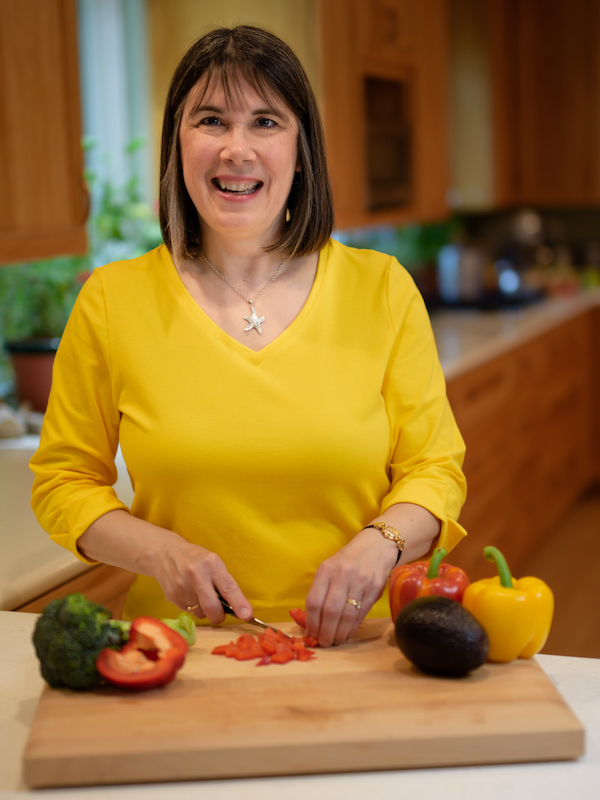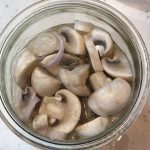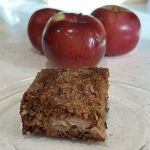Baking the filling in the pepper transforms the pepper into something a shell of “deliciousness,” and adds another dimension of flavor to the filling. Whether you are cooking for a crowd or extra meals for your freezer, read on!
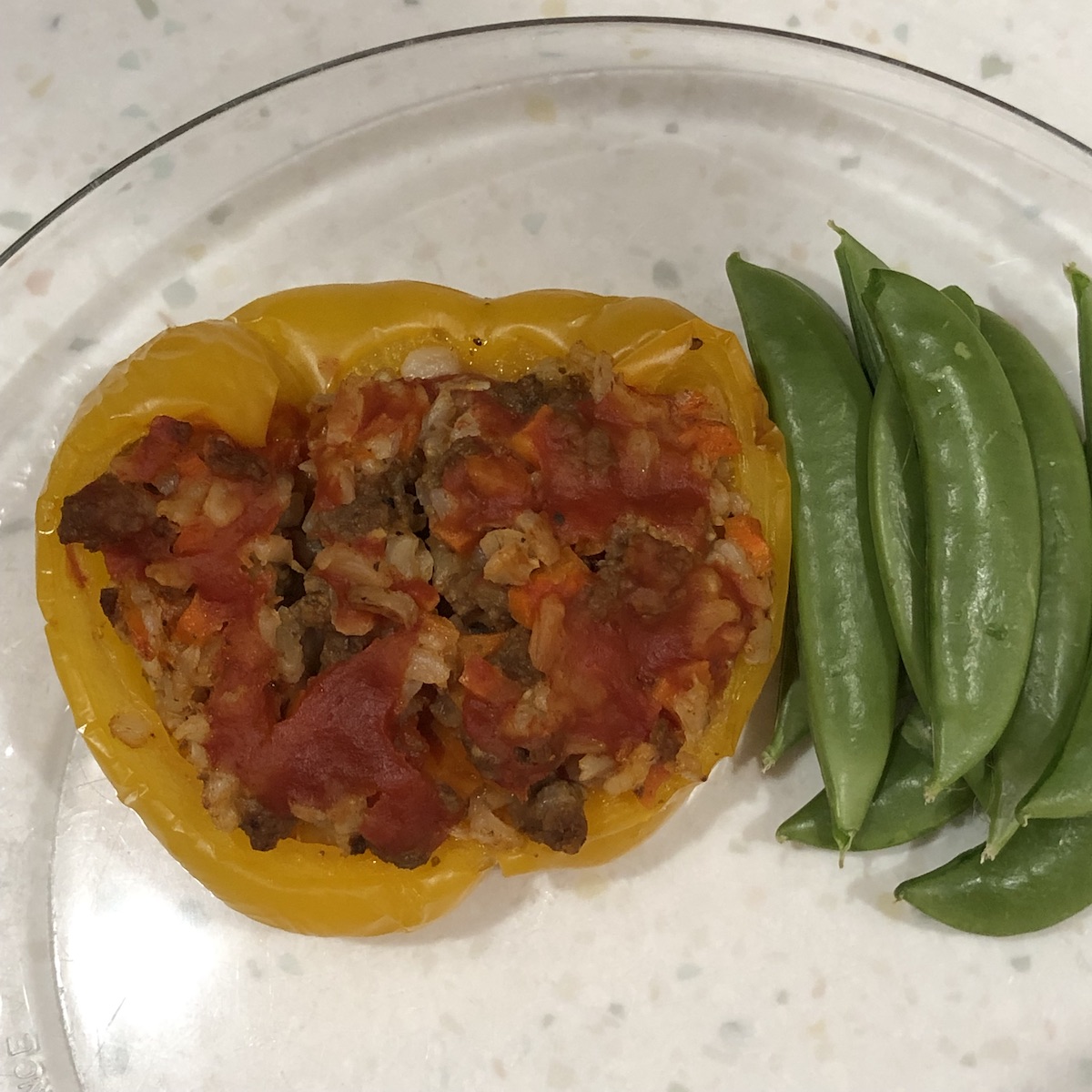
Did you grow up eating stuffed peppers? If so, these are comfort food. If not, then you are in for a treat.
This recipe makes a large quantity so you can feed a crowd or you can use my cook once, eat (at least) twice philosophy and freeze some for later. This recipe takes a little longer than some, but it is worth it for the extra for later in the week or for your freezer.
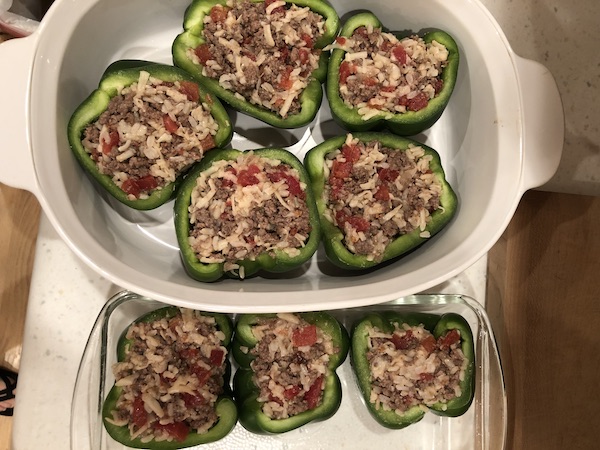
My first stuffed pepper recipe I developed lives on a piece of yellow legal pad paper that I wrote out years ago. I got some ideas from Cook’s Illustrated recipe (like combining the ketchup with juice from the canned tomatoes – genius!) and have continued to modify it over the years.
I have streamlined the recipe to make these less fussy and easier than many stuffed peppers recipes.
- I cut the peppers in half . It is SO much easier to stuff and work with than using whole peppers and trying to scoop out the seeds. Plus it takes less time to thaw if you freeze them.
- I stuff my peppers raw. To not have to boil the peppers, put in cold water to stop the cooking, drain the peppers and try to stuff floppy peppers, saves time and energy. To say nothing of the large pot, bowl, slotted spoon etc that do not need washing.
- I cook the filling before baking the peppers. This reduces the baking time.
- I use cooked brown rice from my freezer. (I bake my brown rice in a 9×13 pan and freeze most of it. That way it is ready for meals.) Leftover rice will work, or you can cook some fresh. The amount of rice is approximate. I use about as much rice as meat. Use more or less to your taste.
To add nutrients
- I add carrots to the filling. They add interest, a touch of sweetness, and more vegetables without even trying! Plus the beta-carotene soars.
- I add cheese to the filling. It helps the filling stick together better when the peppers are eaten and adds creaminess to the filling. Protein, calcium and riboflavin are added. If you are avoiding dairy, use a non-dairy shredded cheese or leave it out.
Ingredients

- peppers – green or colored or combo. Pick peppers that have two flatter sides if possible. Since you will be cutting the peppers in half from top to bottom, they will be laying on a side when stuffed.
- meat – lean – gr sirloin (turkey or chicken or pork should work – will change flavor)
- rice – I use cooked, frozen brown rice. You can cook rice or use leftover.
- canned diced tomatoes. I use petite diced.
- shallot or onion
- garlic
- carrot, chopped finely
- shredded cheese
- ketchup
Preparation
Prepare the peppers
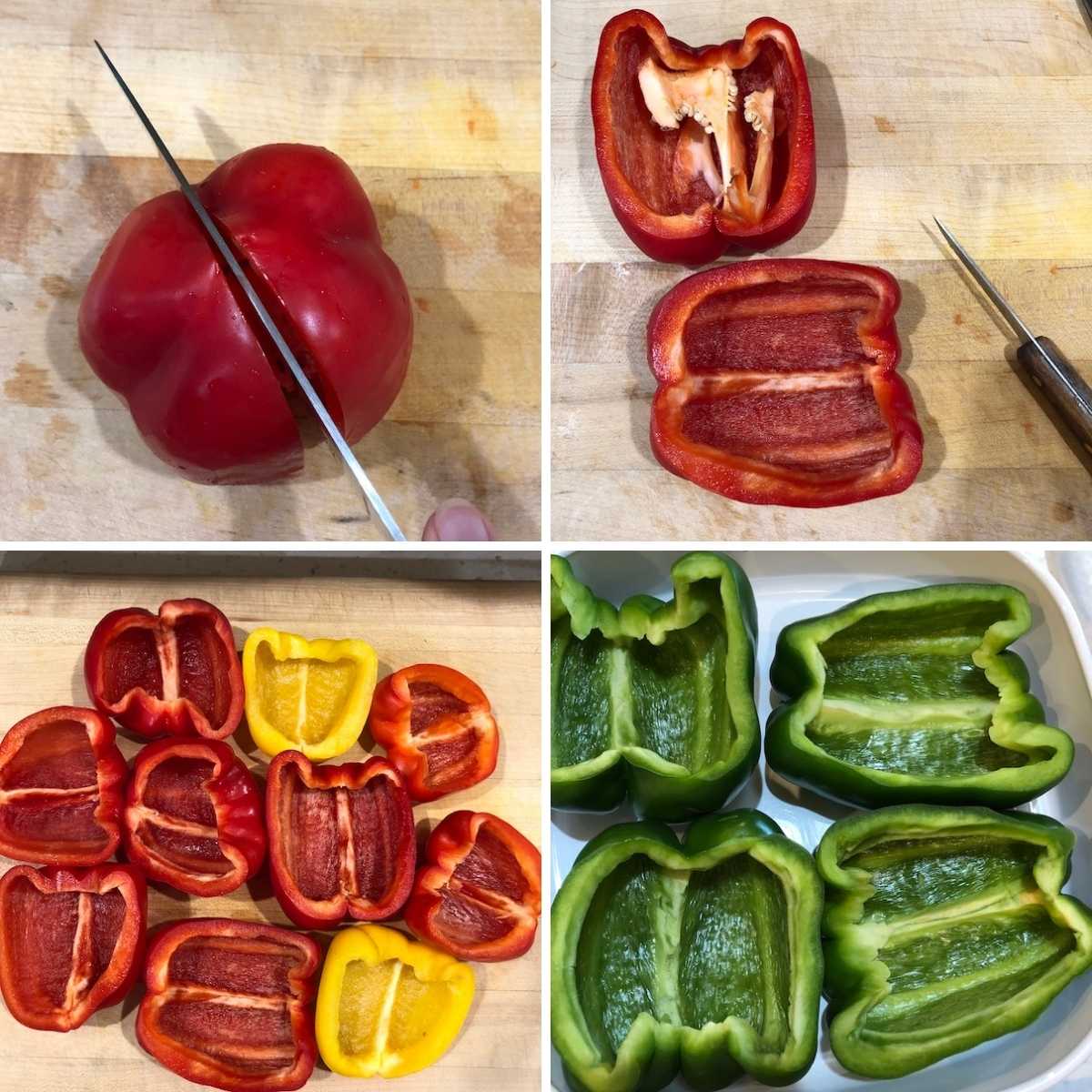
- Rinse the peppers and look for the flatter sides so the pepper will lie flat when stuffed. Cut in half from top to bottom (stem to blossom end not around the “equator” of the pepper.)
- Carefully cut around the stem and remove the stem and seeds. You may need to also remove some ribs and seeds from the sides.
- Arrange the peppers in a single layer in baking dishes. I often use corning ware as it can go into the freezer and the oven.
Note: Most cookware that is not metal cannot go directly from the freezer to the oven or it will shatter. Let it thaw overnight in the refrigerator or thaw at low power in the microwave.
Prepare the filling.
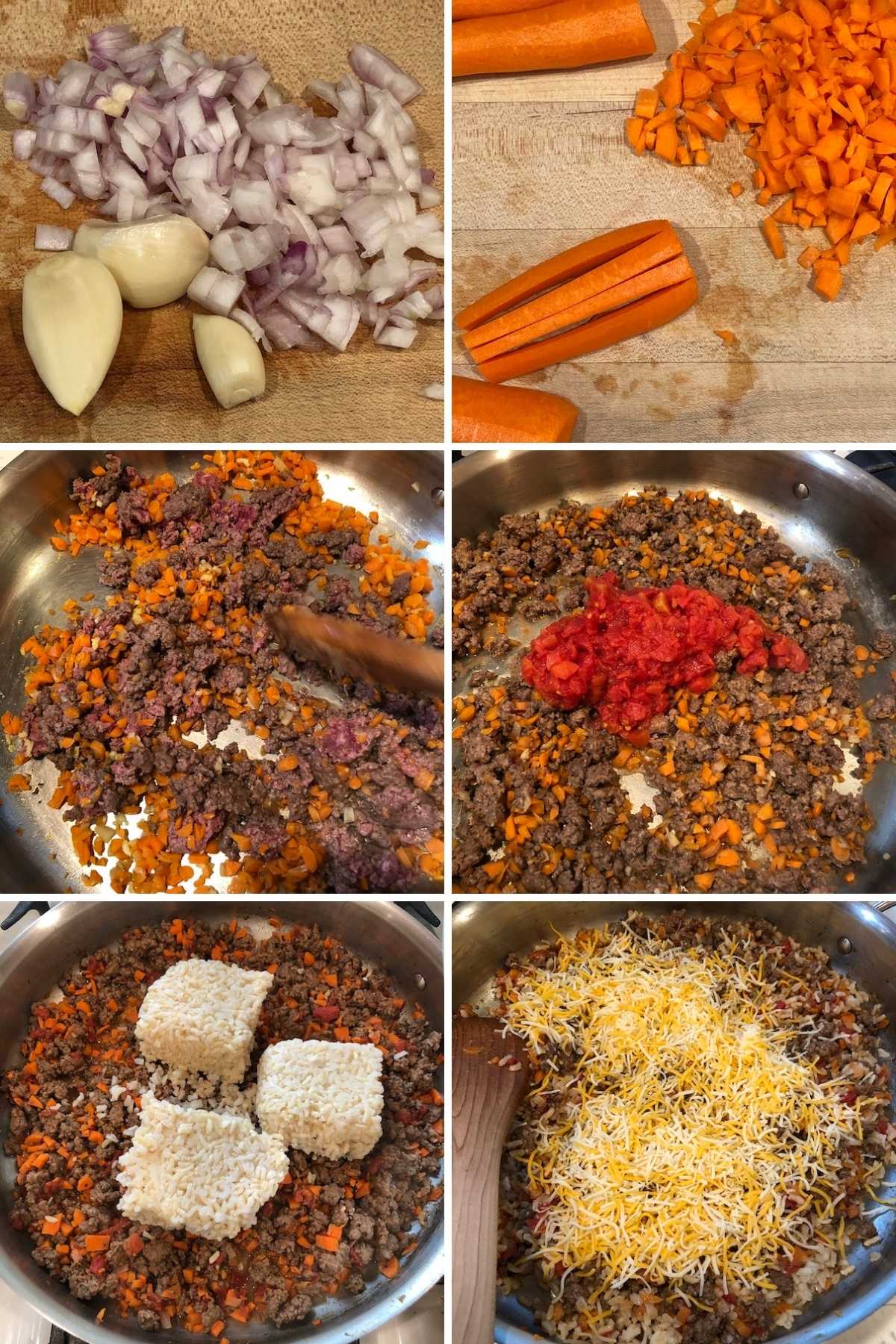
- Cut the garlic, shallots (or onions), and carrots.
- Add the vegetables and the ground meat to the pan. Stir until no large chunks of meat remain. Cook until meet is browned.
- Drain the tomatoes and reserve 1/4 cup of the liquid. Add the tomatoes to the pan. Stir,
- Add rice to the pan. If the rice is frozen, put it on top on low heat until the rice thaws.
- Take off the heat and add cheese. Stir until cheese melts.
Finishing the Peppers
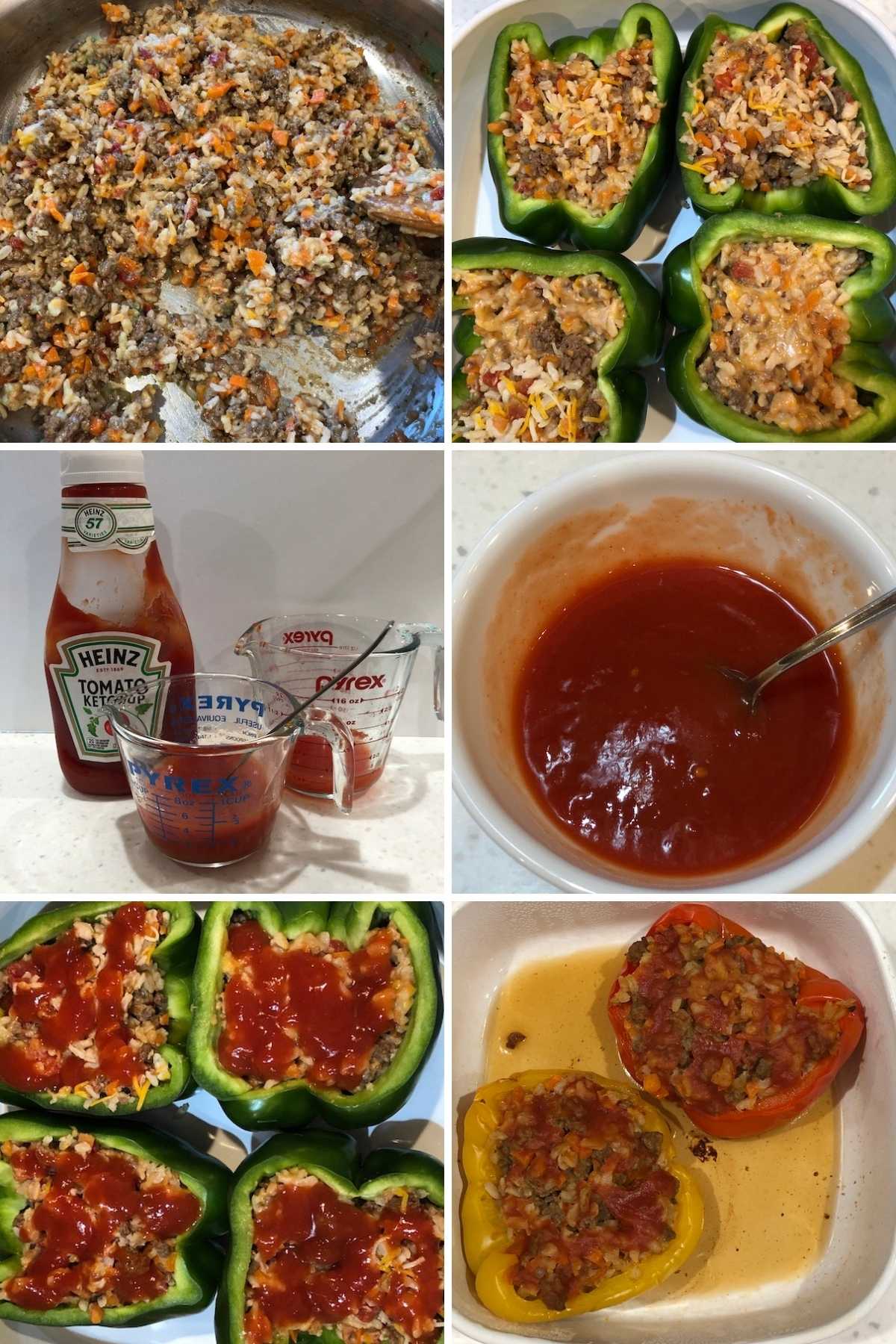
- Fill the peppers with filling.
- Combine reserved tomato juice with ketchup. Spoon tomato mixture over stuffed peppers.
- Bake at 350 degrees for about 30 minutes. Eat right away or cool and freeze covered.
Can I freeze them?
I usually cover my cooled peppers with a piece of plastic wrap and the plastic covers that came with my corningware. Other glass or metal containers will freeze well, but how they are covered will influence how long they keep in the freezer. Plastic wrap under foil will keep the moisture in longer than just foil, but it will not last as long as a plasic or silicone sealed lid. Mine keep for several months in the freezer.
I freeze mine right in the CorningWare then reheat in the microwave (or oven) when ready to eat. Just be sure not to put a frozen ceramic pan directly from the freezer into the oven. Thaw in the refrigerator or microwave first.
I have also frozen the filling when I had extra. This is harder to manage because the cheese makes it harder to thaw and then fill the peppers.
Health Benefits and Nutrients of Sweet or Bell Peppers
Bell peppers are a nutrient powerhouse. One serving of bell peppers is 1 cup chopped, raw or cooked, or 1 medium raw bell pepper and contains:
- Calories: 31
- Total fat : 0.4 g
- Cholesterol: 0 mg
- Sodium : 4.8 mg
- Total carbs : 7.2 g
- Dietary fiber: 2.5 g
- Sugar: 5 g
- Added sugar: 0 g
- Protein : 1.2 g
Vitamins, Minerals and Other Micronutrients
- Vitamin C : 169% of your Daily Value (DV)
- Vitamin A : 21% DV
- Vitamin B6 : 20% DV
- Folate: 14% DV
- Vitamin E: 13% DV
- Vitamin B1: 5% DV
- Vitamin B2: 8% DV
- Vitamin B3: 7% DV
- Vitamin B5: 8% DV
- Vitamin K: 5% DV
- Potassium: 5% DV
- Manganese : 6% DV
In terms of nutrients, it does make a difference what color pepper you have selected.
Green are immature – they contain less sugar and fewer nutrients because they have not had a chance to fully develop. The notable exception to this rule however are the compounds known as polyphenols. Polyphenol rich diets provide protection against the development and progression of many chronic diseases and conditions including cancer, diabetes, cardiovascular problems, and aging.
Nutritionally, yellow and orange peppers are very similar. But there are a few significant differences between red, and yellow/orange.
Per 100g, yellow and orange peppers contain about 60 mg more vitamin C, however they contain fewer and different carotinoids which are a family of naturally occurring antioxidant compounds. Different carotenoids have different levels of absorption and protect different parts of the body. For example luetin is especially important in protecting your retina and vision.
In the past we have heard more about beta carotene because it is more easily absorbed and turned into vitamin A. However the more research is done, the more we realize the beneficial effects of a wide variety of carotenoids.
Generally, the dark red colored fruit presents the highest total carotenoids content compared with those with lighter color and non-red peppers. The amount in red peppers is approximately four to five times higher than in green peppers.
The health promoting effects of bell peppers are being studied but there is some evidence for bell peppers helping control blood glucose, weight gain, protection against skin aging, maintaining the function and structure of the retina which is important in eye health and vision, cardiovascular disease, local anti – inflammatory properties to reduce pain. For more detail on these effects see The Sensitive Kitchen podcast, episode053. (References are there as well.)
For more recipes featuring bell peppers try Gluten Free Stir Fry – without Soy
Protein Pasta Salad with Marinated Beans (gluten free and vegan options)
Asparagus and Red Pepper Salad
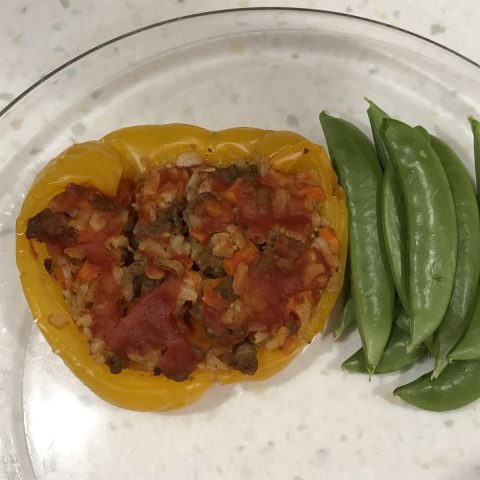
Gluten Free Stuffed Peppers
Ingredients
- 4-5 peppers, green or colored
- 1 pound lean ground beef
- 1 large carrot, finely chopped optional
- 1 small or medium onion or 2 shallots
- 3 cloves garlic, minced
- 14½ ounce can petite diced tomatoes, drained with 1/4 cup juice reserved
- 1½-2 cups cooked brown rice or white rice
- 1 cup shredded cheese (4 ounces)
- ¼ cup ketchup
Instructions
Prepare the Peppers
- Rinse the peppers and look for the flatter sides so the pepper will lie flat when stuffed.
- Cut in half from top to bottom (stem to blossom end not around the "equator" or middle of the pepper.)
- Carefully cut around the stem and remove the stem and seeds. You may need to also remove some ribs and seeds from the sides.
- Arrange the peppers in a single layer in baking dishes.
Prepare the Filling
- Cut the garlic, shallots (or onions), and carrots.
- Add the vegetables and the ground meat to the pan. Stir until no large chunks of meat remain. Cook until meat is browned.
- Drain the tomatoes and reserve 1/4 cup of the liquid. Add the tomatoes to the pan. Stir.
- Add rice to the pan. If the rice is frozen, put it on top of the meat vegetables mixture so it does not stick. Simmer over low heat until the rice thaws. If you have a cover to go over the frying pan, it will speed the thawing.
- Take off the heat and add cheese. Stir until cheese melts.
Filling and Baking
- Place pepper halves in pans. Fill the peppers with filling.
- Combine reserved tomato juice with ketchup. Spoon tomato mixture over stuffed peppers.
- Bake at 350 degrees for about 30 minutes, until pepper is tender when stabbed with a fork.
- Eat right away or cool and freeze covered.

